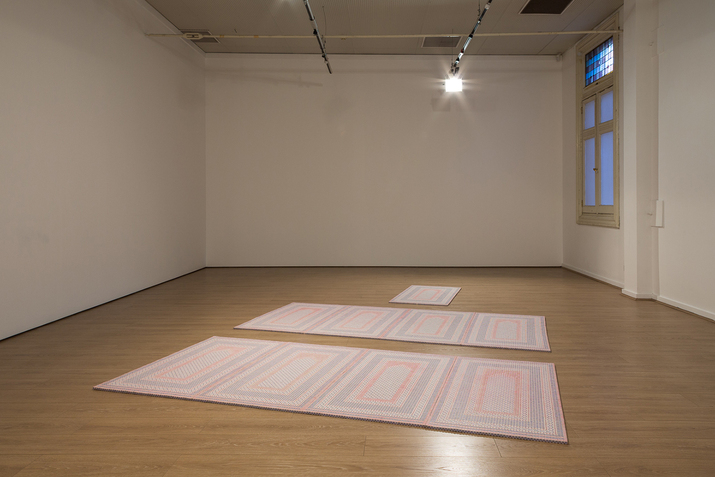-
From Current Issue
-
- Editor’s Letter Fire in the Heart
- Reviews I Gusti Ayu Kadek Murniasih
- Reviews 11th Seoul Mediacity Biennale: “One Escape at a Time”
- Dispatch Networked China
- One on One Monira Al Qadiri on Yukio Mishima
- Essays The rise of independent art spaces in pandemic-era Shanghai
- Features Tuan Andrew Nguyen
- Table of Contents
- Web Exclusives
- Archive
- Subscribe

R
E
V N
E
X
T
The title of 4A Centre for Contemporary Asian Art’s latest exhibition, “I don’t want to be there when it happens,” is a quote from a 1975 Woody Allen play titled Death, in which one character says to another, “It’s not that I’m afraid to die, I just don’t want to be there when it happens.” The four artists taking part in the show are all concerned with the arbitrary nature of death in conflict zones, often the result of religious and ideological intolerance or sectarian violence. Featured were Raj Kumar and Adeela Suleman from Pakistan, where life can be cheap and conflict is endemic; on the other hand, David Chesworth and Sonia Leber, a Melbourne-based duo, are physically and conceptually cocooned from such unmitigated violence by the very nature of where they live. The artists wrestle with mankind’s enduring preoccupation with war in all its guises, from boots-on-the-ground combat to the anonymity of remote drone strikes, from their various locations.
Hanging in the entrance to the gallery was a chandelier by Suleman, composed of hundreds of linked, hand-beaten tin birds, which shares its name with the exhibition’s title. Of similar construction was After All Its Always Someone Else Who Dies (2017), a sheath-like curtain placed in the stairwell. For Suleman, who lives in Karachi, her art is about bearing witness to the many violent deaths that take place in the city. Pakistan is a country created from the 1947 partition of India as a way of stymying the growing violence between Hindus and Muslims. Today, the two countries remain locked in various bloody ideological disputes; religious intolerance is a euphemism for brutality and justice is meted out through indiscriminate recourse to bullets and bombs. Each bird in Suleman’s works serves as a monument to a life claimed by sectarian violence in Karachi. The shadows from these installations transmogrify from birds to revolvers, a reference perhaps to the precariousness of sudden death hiding in the shadows behind the elusive sense of normality. Ultimately, Suleman’s project is a futile exercise, as she is unable to keep pace with the acts that claim more lives than she can commemorate.
Similarly, Raj Kumar examines how precarious life can be if you are a member of the “wrong” religion or sect. For his installation Meet, Pray and Pay (2017), Kumar wove 37,152 dice into nine prayer mats that mimic regional textile patterns and Persian tile decorations, laying them on the gallery’s floor pointing towards Mecca. The premise here is glaringly obvious and perhaps even flimsy—life and death is as arbitrary as the throw of a dice. Even so, the prayer mats possess a curious and captivating presence, and demonstrates that good art need not be conceptually rarefied or obscure.
On the second floor of the gallery was a work by Chesworth and Leber. Their installation comprises a dreary video titled Earthwork (2016), displayed on a small light box that is laid flat on the floor. Filmed with a hand-held camera, the moving image offers a drone-like bird’s eye view of a decimated landscape, which on closer inspection is revealed to be a discarded model of a suburban housing estate. The work references the control systems of predator drones, which were actually based on Xbox and Play Station game consoles; the more important inference being that the directors of these indiscriminate killing machines remain safely ensconced in America while delivering death to the inhabitants of Pakistan, Afghanistan or any other target deemed “suitable” for their attention. Earthwork, which runs on a five-minute loop, possesses none of the sublimity of Kumar’s work and is clumsy in comparison.
One would like to say that this is a tightly curated, carefully constructed show but ultimately the four works remain somehow adrift within the otherwise empty spaces, which come dangerously close to overwhelming the exhibits. The exhibition will move on to the Perth Institute of Contemporary Arts—partners in this exhibition—where further works by Raqs Media Collective, Reena Saini Kallat, Mithu Sen and Abdullah MI Syed, will be added.
“I don’t want to be there when it happens” is on view at 4A Centre for Contemporary Asian Art, Sydney, until October 8, 2017. The exhibition will then tour to Perth Institute of Contemporary Arts, Perth, where it will be presented from November 11 to December 24.
To read more of ArtAsiaPacific’s articles, visit our Digital Library.







